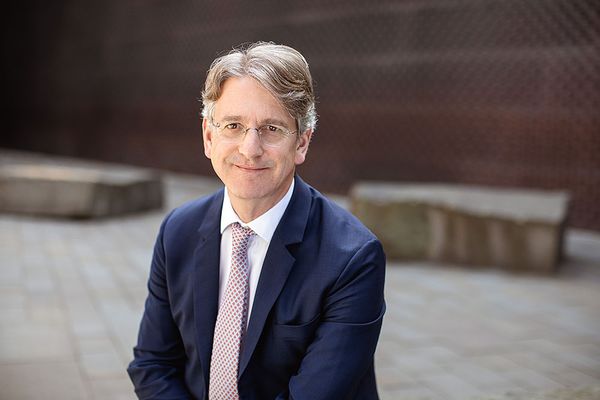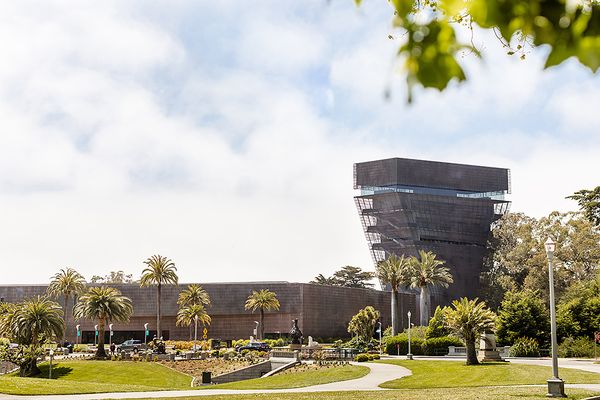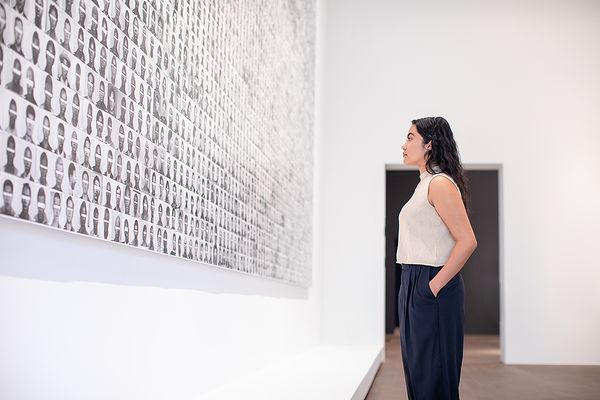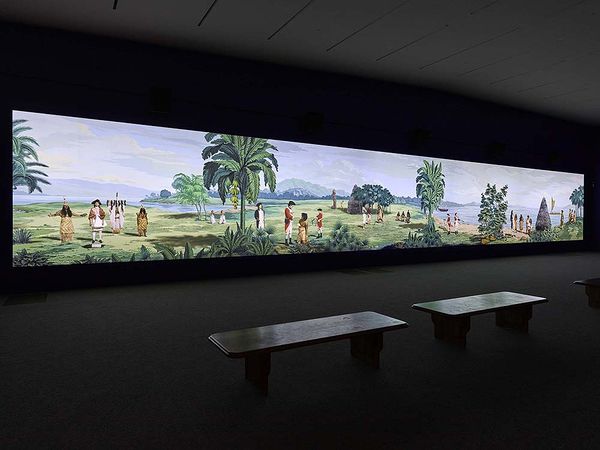Lisa Reihana, in Pursuit of Venus [infected], de Young museum, San Francisco, 2019. Courtesy of the Fine Arts Museums of San Francisco.
PHILLIPS: The deYoung recently celebrated its 125th anniversary. What do you foresee as some of the short term goals for the museum and the visibility of its preeminent collection?
THOMAS P. CAMPBELL: We will return to a core value of the institution’s founding, which is that we are the museums of the city of San Francisco. This is a humbling role to fill, and being a better resident of our city is a challenge we are eager to take on. As a cultural voice in a city which has a decreasing minority population and increasing gentrification, our aim is that our visitorship will include the full demographics of San Francisco, including those that historically haven’t been frequent visitors, or even haven’t visited at all.
Our first step here was to launch free admission on Saturdays for all Bay Area residents, which has dramatically increased the breadth of visitors. The program will continue through summer 2021, due to the generosity of our long-standing supporter Dede Wilsey, and we hope it will continue to bring in visitors who don’t typically visit often, or who are new to the museum. The free admission is just the start and the program includes free public programming, among other aspects.

Thomas P. Campbell, Director and CEO of the Fine Arts Museums of San Francisco. Photography by Gary Sexton. Courtesy of the Fine Arts Museums of San Francisco.
Another focus for the next few years is our continued commitment to building our modern and contemporary art programming and collection. Presented in dialogue with our historical collections, it provides connections between past and present, and new views on established narratives. The context of the artist and the time in which they live are as important to present as the work itself. Our goal as an institution is to start a conversation, where our visitors will leave with a different perspective than when they arrived. This of course, is the point of art. It should be challenging, beautiful, and also, at times, difficult. It can offer an open set of questions, delivering not one viewpoint, but many.

The de Young Museum. Photography by Gary Sexton. Courtesy of the Fine Arts Museums of San Francisco.
P: As a director, you’ve made online content one of your priorities. How do you see the digital forum addressing the greater needs of the Fine Arts Museums and it’s civic role in the San Francisco community?
TC: We see our website and art database as the digital face of the institution and our collections -- a channel through which we continue our mission of connecting our audiences with art, and education beyond the physical walls of the museums. With the museums closed these past months, our digital channels have become even more crucial as a platform for sharing our collections, programming, and educational curriculum as a resource for visitors confined at home. As we now move to reopen the museums we will continue to prioritize digital engagement, to keep connecting with visitors who may hesitate or even be unable to return to the museums in person. As an example, our public programming will be held online until 2021, and we are in the process of transferring our collections onto a new, more intuitive database that will enable our audiences better access to our collections remotely.

The de Young Open: R.L. Butterfield, Rehabilitation of the Abandoned Metropolis, 2020. Courtesy of the artist.
P: You recently announced The de Young Open, an exhibition in support of the Bay Area creative community. Can you speak to the inspiration behind this effort?
TC: As Bay Area residents were confined at home this past spring, we explored how we, as an institution, could help support the local art community. With the de Young museum celebrating 125 years as a platform for art in the city, we landed on opening our galleries to the community through The de Young Open - an open invitational exhibition for all Bay Area artists. We are thrilled to see the response - almost 12,000 submissions from 6,000 artists across a wide range of mediums. Our curators, together with artist jurors Mildred Howard, Enrique Chagoya, and Hung Liu, have selected close to 900 works that will fill the walls of our special exhibition galleries from floor to ceiling. As a small gesture towards economic support, artists will be permitted to sell their work on view.
Many of the submissions channel the current moment and the exhibition will be on view in dialogue with Frida Kahlo: Appearances Can Be Deceiving. The exhibition features a range of works by the artist from her periods of confinement, drawing inspiration from the subject matter available to her; her own appearance and clothes, not to mention her bodily suffering; her pets; the objects around her house; the landscape of her imagination.

Lynn Hershman Leeson, Shadow Stalker, 2019. Courtesy of the Fine Arts Museums of San Francisco.
P: Is there a particular work(s) from the collection that speaks to you at this moment in time?
TC: It’s difficult to choose, but Lisa Reihana’s in Pursuit of Venus [infected] for one, is frequently on my mind. Her momentous, mesmerizing video scroll, that responds to romanticized narratives of Captain Cook’s explorations in the South Pacific, is a great example of our contemporary reassessment of colonial legacies.
Another work that comes to mind is the newly acquired work Shadow Stalker by Lynn Hershman Leeson. The installation addresses internet systems used for racial profiling, such as Predictive Policing, which resonates with the current social climate and pinpointing of systemic racism.

Uncanny Valley: Being Human in the Age of AI at the de Young museum. Installation view of Trevor Paglen, They took the Faces from the Accused and the Dead... (SD18). Photography by Gary Sexton. Courtesy of the artist, Altman Siegel Gallery, San Francisco and the Fine Arts Museums of San Francisco.
P: What is an exhibition or artist project that you are most looking forward to tackling in this next year?
TC: In Summer 2021 we will exhibit a series of paintings by Hung Liu, a pre-eminent Chinese American artist based here in the Bay Area. Recently denied exhibiting her work in China, we are thrilled to be able to get the opportunity to show her urgent perspective on Chinese culture, gender, history and memory at the de Young museum.
I am also looking forward to our continued exploration of the fraught relationship between humans and the machine in the eye-opening exhibition Uncanny Valley: Being Human in the Age of AI, which will be on view from reopening until Spring 2021. With our recently increased dependency on tech during the pandemic, the exhibition certainly has renewed relevance. During this time, we have explored the issues addressed in a series of conversations between our contemporary curator Claudia Schmuckli and the artists in the exhibition (available to watch on our Facebook page).

Discover More about the Fine Arts Museums of San Francisco >
